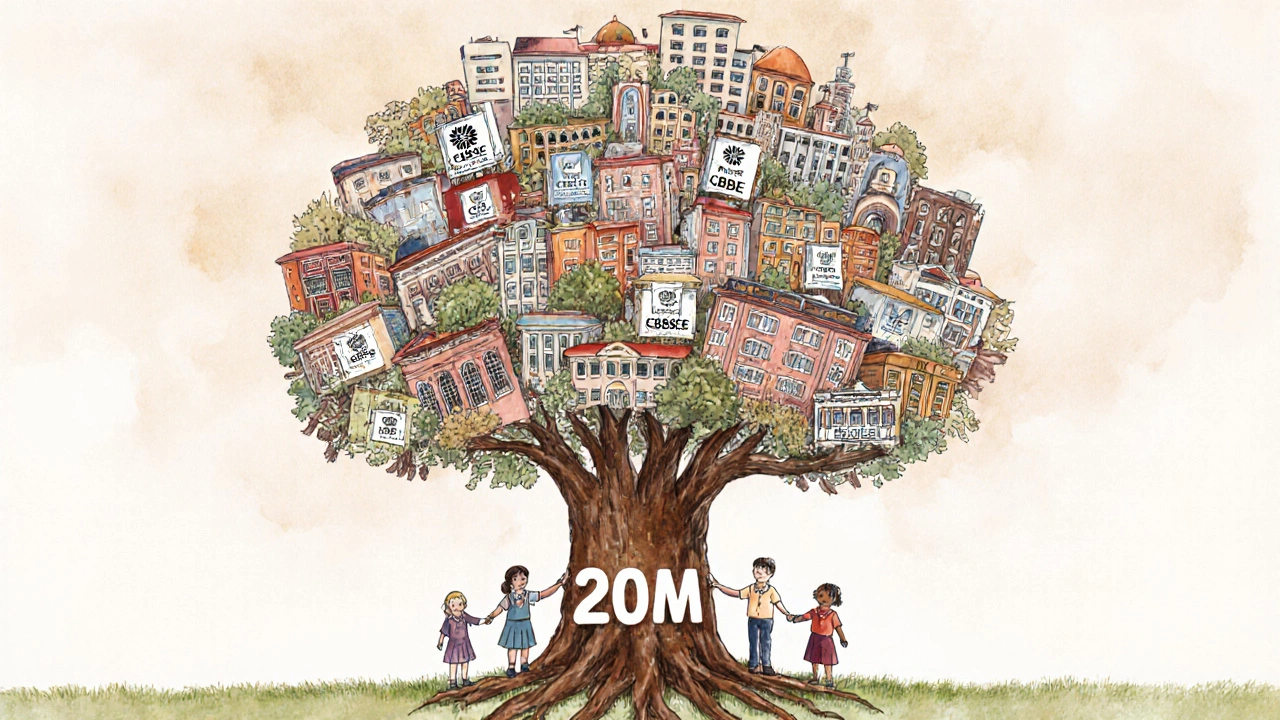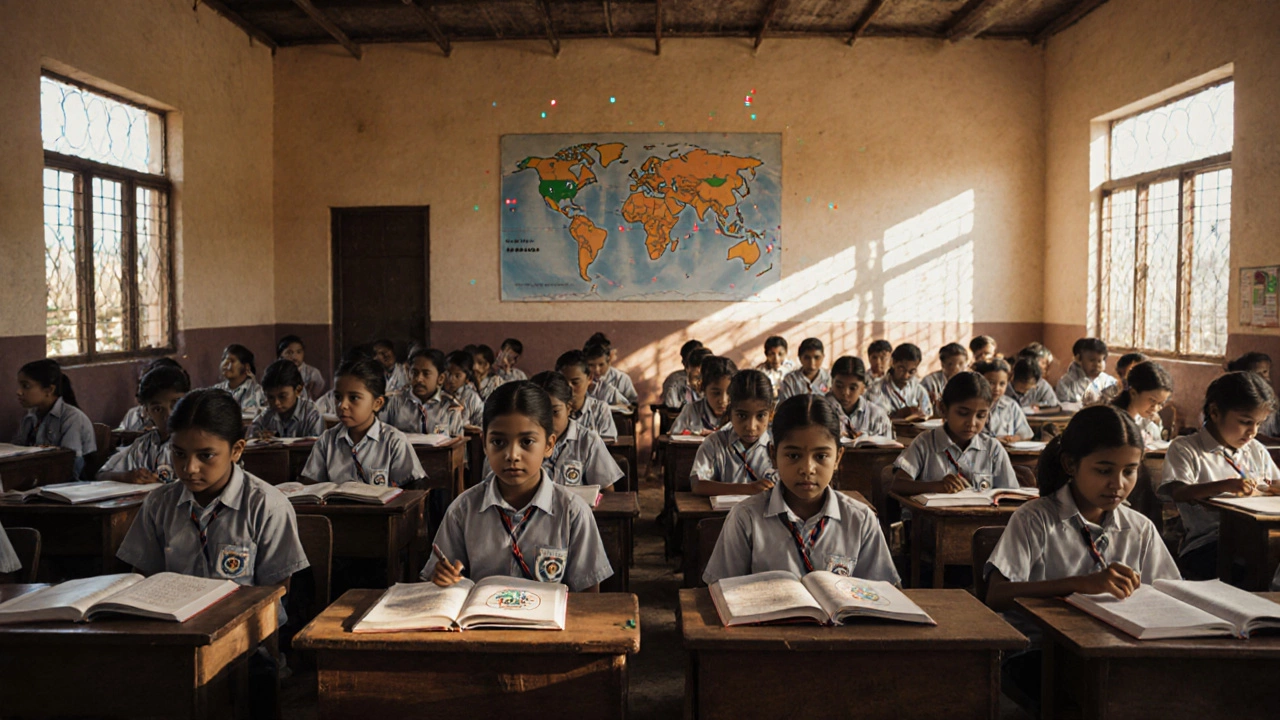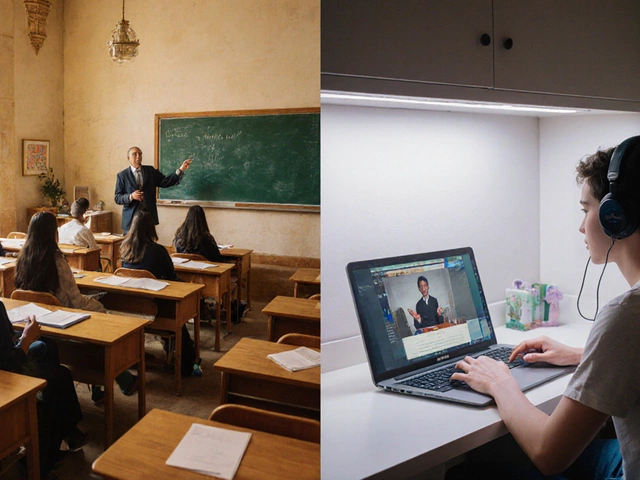Global School Board Student Count Comparison
Compare Education Board Student Populations
CBSE serves over 20 million students worldwide. See how other boards compare using these estimates:
Comparison Results
CBSE vs Other Boards:
CBSE Student Count: 20,000,000 students globally
Comparison: More students than the entire population of Australia (26 million) and Poland (38 million)
Why CBSE Dominates:
- Standardized curriculum for nationwide mobility
- Direct alignment with JEE/NEET competitive exams
- Cost-effective for middle/low-income families
- Global recognition by universities worldwide
- Over 25,000 schools in India and 250+ internationally
When you ask which school board is most popular in the world, the answer isn’t about prestige or international recognition-it’s about raw numbers. Over 20 million students are enrolled in schools following the CBSE syllabus across India and abroad. That’s more than the entire population of countries like Australia or Poland. No other board comes close. CBSE isn’t just popular in India; it’s the most widely followed curriculum on the planet by student count.
Why CBSE Dominates in Student Numbers
The Central Board of Secondary Education (CBSE) is run by the Indian government and oversees nearly 25,000 schools in India and over 250 schools in 28 other countries. Its reach stretches from Dubai to Singapore, from Nairobi to Moscow. What makes it so widespread? Simplicity and standardization. CBSE designs its syllabus to be uniform across the country, so students who move from Delhi to Bangalore don’t have to relearn entire subjects. This makes it ideal for military families, government employees, and migrant workers.
Unlike state boards that vary wildly in content and difficulty, CBSE follows a national framework aligned with NCERT textbooks. These books are used in over 90% of CBSE-affiliated schools. The content is clear, structured, and focused on core concepts in science and math-exactly what competitive exams like JEE and NEET require. That’s why parents in small towns across Uttar Pradesh or Bihar choose CBSE: it gives their kids a direct path to engineering and medical colleges.
CBSE vs ICSE: The Real Difference
Many people compare CBSE with ICSE (Indian Certificate of Secondary Education), another major board in India. ICSE is known for being more detailed, with heavier emphasis on English, literature, and project work. But here’s the catch: ICSE schools make up less than 10% of all private schools in India. CBSE schools outnumber them by nearly 10 to 1.
ICSE is popular in urban centers like Mumbai and Kolkata, where families value broad-based learning. But CBSE wins in scale because it’s designed for mass adoption. The exam pattern is predictable. The marking scheme is transparent. The syllabus doesn’t change drastically year to year. For a parent in Jaipur or Ranchi, that predictability matters more than depth.
CBSE also updates its syllabus faster. In 2023, it introduced AI as a subject in grades 6-8. By 2025, over 8,000 CBSE schools had started teaching basic coding and machine learning concepts. ICSE hasn’t rolled out anything similar at that scale.
Global Reach: CBSE Outside India
CBSE isn’t just an Indian board-it’s a global brand. The Indian diaspora has set up CBSE schools wherever they live. In the UAE, over 150 CBSE-affiliated schools serve Indian expat families. In the UK, CBSE is offered in over 20 private schools, including ones in London and Birmingham. Even in countries like Kenya and Vietnam, you’ll find CBSE schools catering to Indian workers and diplomats.
Why do foreign schools choose CBSE? Because it’s recognized by universities worldwide. Universities in the US, Canada, Australia, and the UK accept CBSE qualifications without requiring additional exams. The board even offers an international version called CBSE International (CBSEi), which aligns with Cambridge and IB standards while keeping the core CBSE structure.
Compare that to state boards like Maharashtra’s SSC or Tamil Nadu’s SSLC. They’re only recognized within India. If you move abroad, you’ll likely need to retake exams or enroll in a bridging course. CBSE doesn’t have that problem.

The Exam Advantage: JEE, NEET, and Competitive Success
If you want to get into an IIT, AIIMS, or any top engineering or medical college in India, CBSE is your best bet. The JEE Main and NEET exams are designed around the CBSE syllabus. Questions are pulled directly from NCERT textbooks. A student preparing for JEE using CBSE books has a clear roadmap. An ICSE or state board student has to spend extra months relearning topics that were covered too shallowly-or not at all.
According to data from the National Testing Agency (NTA), over 85% of JEE Main qualifiers in 2024 came from CBSE schools. The same pattern holds for NEET: 82% of top rankers were CBSE students. That’s not coincidence. It’s structure.
CBSE also runs its own entrance test for Class 10 and 12-AISSE and AISSCE-that mirrors the format and difficulty of national exams. That means students are practicing the real thing from day one.
Why Other Boards Don’t Match Up
Other boards have strengths. The International Baccalaureate (IB) offers critical thinking and global perspectives. Cambridge Assessment (CIE) is respected in the UK and Commonwealth. But they’re expensive, rare, and designed for a small elite. IB schools cost $15,000-$30,000 per year. CBSE schools cost $200-$1,500. That’s the difference between a luxury option and a mass-access system.
State boards like Maharashtra’s SSC or West Bengal’s WBBSE are deeply rooted in local culture and language. But they lack standardization. A student from Bihar can’t easily transfer to a school in Gujarat. Their textbooks, exam patterns, and grading systems are completely different. CBSE fixes that.
Even the NIOS (National Institute of Open Schooling), which serves dropouts and remote learners, uses the CBSE syllabus as its base. That tells you everything-CBSE isn’t just popular. It’s the foundation.

What This Means for Students and Parents
If you’re choosing a board for your child, and your goal is access-access to top colleges, mobility across cities, international recognition-CBSE is the only choice that delivers on all fronts. It’s not about being the hardest or the most creative. It’s about being the most reliable, the most scalable, and the most connected.
For students, it means fewer surprises. Less stress over syllabus changes. More time to focus on practice, revision, and actual learning. For parents, it means knowing their child’s education won’t be disrupted by a job transfer or a move abroad.
CBSE doesn’t claim to be perfect. It’s criticized for rote learning and heavy exam pressure. But those are problems with how it’s taught-not with the board itself. The syllabus is modern, updated regularly, and aligned with global trends in STEM education. The system is flawed in execution, but unmatched in reach.
Final Verdict: The Most Popular Board in the World
No other education board in history has reached 20 million students. Not the UK’s GCSE. Not America’s Common Core. Not Japan’s national curriculum. CBSE has done it-and it’s growing. With India’s population under 18 expected to hit 400 million by 2030, CBSE’s dominance will only increase.
If you’re looking for the most popular school board in the world, the answer isn’t a guess. It’s a statistic. It’s a number. It’s over 20 million students, one syllabus, and a system that works-for families in rural Punjab and expats in Dubai alike.
Is CBSE the most popular board in India?
Yes. CBSE is the most popular board in India by far, with over 20 million students enrolled across nearly 25,000 schools. It far outnumbers ICSE, state boards, and other national boards combined.
Is CBSE better than ICSE for competitive exams?
For JEE and NEET, CBSE is significantly better. The syllabus, textbooks, and exam patterns are directly aligned with these exams. ICSE covers more topics in depth but often misses the focus areas that appear on JEE and NEET. CBSE students typically need less extra coaching.
Can CBSE students study abroad?
Yes. CBSE qualifications are accepted by universities in the US, UK, Canada, Australia, Germany, and many others. Many CBSE schools offer the CBSE International (CBSEi) program, which meets global standards and helps with university applications.
Why do CBSE schools cost less than IB or Cambridge schools?
CBSE schools follow a standardized, government-supported curriculum using low-cost NCERT textbooks. IB and Cambridge schools require expensive training, materials, and accreditation. CBSE keeps costs low to serve millions of middle- and lower-income families.
Does CBSE offer vocational courses?
Yes. Since 2020, CBSE has introduced vocational subjects like Artificial Intelligence, Data Science, Financial Literacy, and Tourism in grades 9-12. These are optional and designed to give students practical skills alongside academics.









